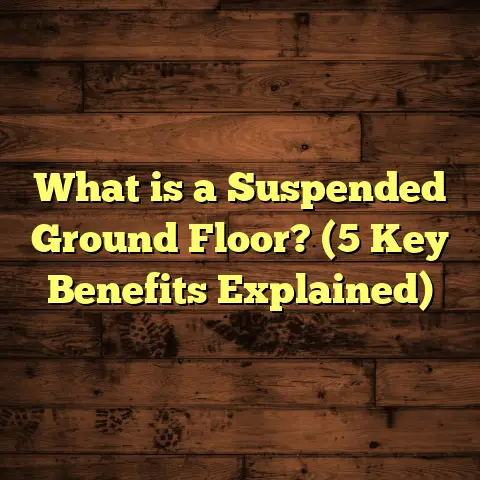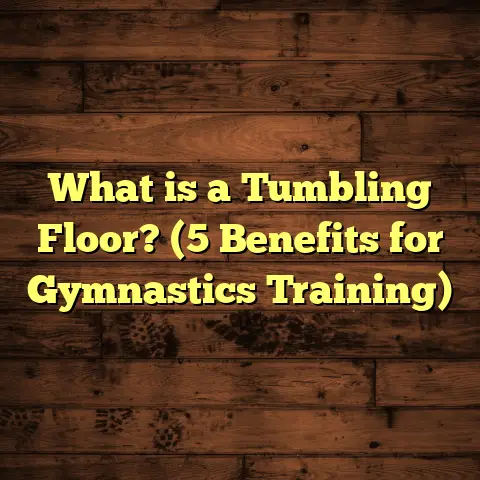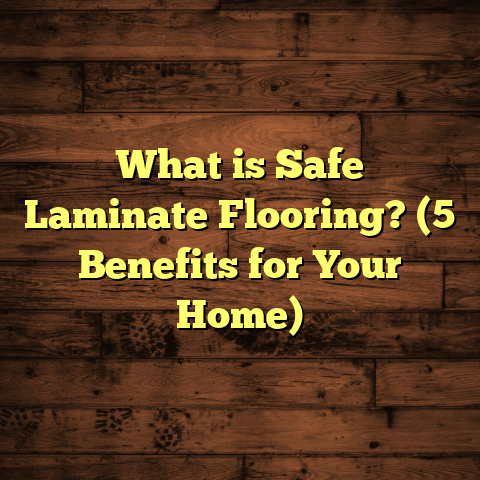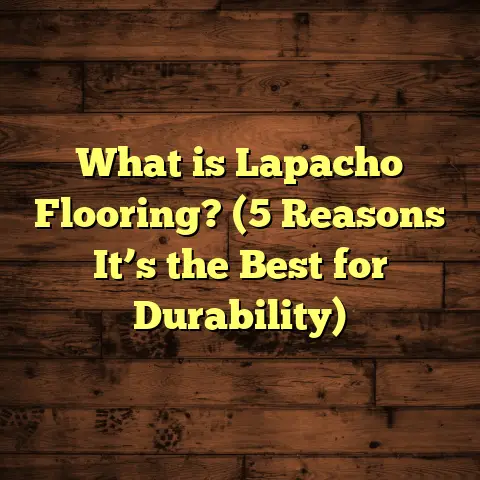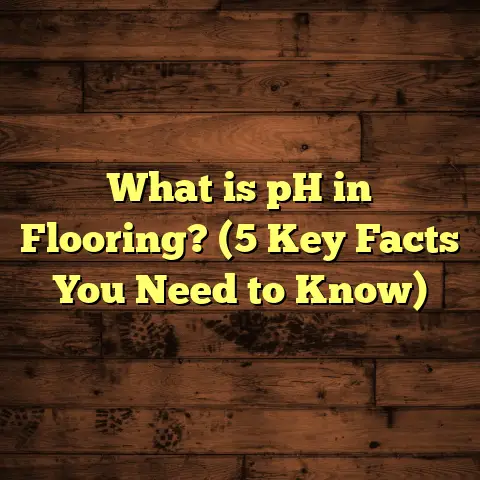What is LVP Flooring? (5 Benefits You Need to Know)
Craftsmanship has always fascinated me. Watching a skilled artisan transform raw materials into something both functional and beautiful is a real treat. Flooring is no exception—laying down a floor isn’t just about covering a surface; it’s about creating an environment where life unfolds, memories form, and comfort is found. Over the years, as I worked on countless flooring projects, I’ve learned that choosing the right material can make all the difference in the world. One material that really stands out today is Luxury Vinyl Plank, or LVP for short. It’s become a go-to for many homeowners and contractors alike, and I want to share everything I’ve learned about it, especially five key benefits you should know about.
What is LVP Flooring?
LVP stands for Luxury Vinyl Plank. It’s a type of vinyl flooring designed to mimic the look and feel of real hardwood planks but without many of hardwood’s limitations. Unlike traditional sheet vinyl, which comes in rolls or sheets, LVP comes in individual plank-like pieces designed to replicate natural wood floors.
Let me break down the typical makeup of LVP flooring for you:
- Wear Layer: This is the clear top coat that protects against scratches, stains, fading, and everyday wear and tear. The thickness of this layer can vary from 6 mils (thousandths of an inch) to over 20 mils on heavy-duty products.
- Design Layer: Underneath the wear layer is a printed design layer. Thanks to modern printing technology, this layer can replicate wood grains, knots, and textures with astonishing realism.
- Core Layer: This is the heart of the plank, providing stability and durability. Some cores are rigid PVC, others are composite materials that add strength and sometimes waterproofing.
- Backing Layer: The bottom layer provides support and sometimes sound absorption or moisture resistance.
Because of this multi-layer construction, LVP offers a combination of aesthetic appeal and practical durability that many other flooring types struggle to match.
My First Experience with LVP
I remember my first encounter with LVP vividly. A client wanted the warm look of hardwood in her kitchen but was worried about water damage from spills and humidity. Hardwood floors in kitchens make me nervous because water can cause warping or stains. I suggested LVP as an alternative that would give her the look she wanted but with much better water resistance.
The installation was quick and smooth, and the final look impressed both of us. The planks had subtle embossing that felt like wood grain, and after living with it for months, she reported how easy it was to clean and maintain. Since then, I have installed LVP in many different settings—from bathrooms to basements to even commercial spaces like gyms and retail stores.
5 Benefits You Need to Know About LVP Flooring
1. Water Resistance That Protects Your Investment
When I first started installing floors, water damage was one of the biggest concerns clients brought up. Hardwood doesn’t tolerate water well—spill something once, and you might have stains or warping. Laminate floors do better but still aren’t completely waterproof.
One of the standout benefits of LVP flooring is its excellent water resistance. Because it’s made from vinyl polymers that don’t absorb water, liquid spills simply sit on top until wiped away.
Some LVP products come with a waterproof core layer as well. This means not only the surface but the entire plank resists moisture intrusion.
Real-World Example: In one project, a family had a flooded basement due to heavy rains. While they lost some items stored on the floor, their newly installed LVP floor remained intact without swelling or buckling—a scenario that would have ruined traditional hardwood or laminate.
Tip: If you’re planning flooring for bathrooms, kitchens, laundry rooms, or basements—areas prone to moisture—LVP should be at the top of your list.
Data Insight: According to a recent flooring industry report, homes with waterproof flooring options like LVP see 30% fewer moisture-related flooring repairs over five years compared to homes with hardwood or laminate.
2. Realistic Look Without the Maintenance Headache
Years ago, vinyl flooring had a reputation for looking cheap or artificial. But luxury vinyl plank floors have changed all that. Thanks to advances in printing technology and embossing techniques, manufacturers can recreate wood textures that closely resemble real hardwood.
I’ve personally seen planks that mimic oak, walnut, hickory, even exotic woods like Brazilian cherry or teak. The embossed textures add a tactile dimension so when you walk barefoot across the floor, it feels authentic.
One client told me she was amazed at how guests complimented her “wood floors” without realizing it was vinyl. She loved that she didn’t have to worry about scratching or refinishing as she would with real hardwood.
Maintenance: With hardwood floors, you need periodic sanding and refinishing to keep them looking new. LVP requires none of that. Sweeping regularly and mopping occasionally with a vinyl-safe cleaner keeps it fresh.
Statistical Fact: Maintenance costs for hardwood average around $1,000–$2,000 over ten years, depending on traffic and care needed. By contrast, LVP maintenance costs often stay below $200 for the same period.
3. Durability That Stands Up to Everyday Life
Durability is a big deal for floors because they take abuse from foot traffic, furniture movement, pets, and spills daily. I’ve installed many flooring types over my career: hardwood can dent or scratch easily; laminate can chip or swell; carpet stains quickly.
LVP stands out because its wear layer protects against scratches and dents while being resilient enough to bounce back from impacts.
In one daycare center I worked with recently, they installed commercial-grade LVP with a 20 mil wear layer. The floors endure constant running kids, dropped toys, and spilled snacks but show almost no signs of wear even after two years.
Advice: When shopping for LVP, look for a thicker wear layer if you expect heavy usage—especially if pets are part of your home life.
Personal Story: I had a client with two large dogs who worried about claw damage on floors. We chose an LVP product rated for high durability with enhanced scratch resistance. After three years, their floors still look like new despite lots of pet traffic.
4. Affordable Beauty That Fits Your Budget
Budget is often a key factor when deciding on flooring materials. Hardwood floors offer timeless appeal but come at a premium price. Between material costs (often $5–$10 per sq ft) plus installation (usually $4–$8 per sq ft), hardwood projects can get expensive quickly.
LVP offers an affordable alternative without sacrificing style or quality. Installed costs typically range from $2 to $7 per square foot depending on brand and product features.
For homeowners wanting to renovate on a tighter budget yet still get a classy look, LVP fits perfectly.
Data: A study by HomeAdvisor shows average flooring costs:
| Flooring Type | Material Cost (per sq ft) | Installation Cost (per sq ft) | Total Cost per sq ft |
|---|---|---|---|
| Hardwood | $5 – $10 | $4 – $8 | $9 – $18 |
| Laminate | $1 – $3 | $2 – $5 | $3 – $8 |
| Luxury Vinyl Plank | $2 – $5 | $1 – $3 | $3 – $7 |
This makes LVP an excellent value choice while still achieving a rich wood appearance.
5. Easy Installation—Great for DIYers and Pros
One aspect I appreciate about LVP is how relatively easy it is to install compared to other flooring types.
Many products use a click-lock system where planks snap together tightly without glue or nails. This makes installation faster and less messy.
For DIYers wanting to save money on labor or contractors looking for quick turnaround times, this feature is invaluable.
I’ve installed LVP in rental properties where tenants needed new flooring fast between leases. The speed meant less downtime and happier tenants moving in sooner.
Pro Tip: Even though installation is easier than hardwood or tile, preparation matters. Make sure subfloors are clean, dry, level, and free from debris before starting.
Additional Insight: Glue-down LVP options exist too—used often in commercial settings for added stability—but require more tools and time.
Additional Considerations Based on My Experience
Thickness Matters More Than You Might Think
LVP thickness varies between products—usually from 2mm up to around 8mm thick including all layers.
Thicker planks generally provide better comfort underfoot and reduce sound transmission between rooms or floors below.
From experience:
- 2mm–3mm thickness suits light residential use.
- 4mm–6mm is ideal for most homes.
- 7mm–8mm or more works well in commercial applications or multi-story buildings needing sound insulation.
I once installed thin LVP in an apartment unit without underlayment; tenants complained about noise transmission below. Adding underlayment solved this issue effectively in subsequent projects.
Color and Pattern Selection Can Impact Room Feel
Choosing your plank color isn’t just about what looks good initially; lighting conditions dramatically change how colors appear indoors.
I always recommend clients bring home samples before committing:
- View planks in natural daylight at different times.
- Check under artificial lights used regularly.
- Compare samples against furniture and wall colors.
Darker colors can make rooms feel cozy but may show dust more easily. Lighter colors brighten spaces but might reveal dirt quickly depending on foot traffic patterns.
Environmental Impact—Is LVP Eco-Friendly?
You might wonder about vinyl flooring’s environmental footprint since it’s made from plastic materials.
Many manufacturers today offer products with recycled content or lower VOC emissions for better indoor air quality.
There are also recycling programs emerging specifically targeting old vinyl flooring disposal.
If sustainability matters to you:
- Look for products certified by organizations like FloorScore or GREENGUARD.
- Ask suppliers about recycled content percentages.
- Consider lifecycle impact when comparing vinyl vs hardwood (wood requires forest resources; vinyl uses petrochemicals).
Case Studies From My Projects
Case Study #1: Kitchen Remodel With Family Pets
A couple with two dogs wanted durable flooring that could handle muddy paws after walks but still look elegant in their open-plan kitchen-dining area.
We selected an LVP product with:
- 12 mil wear layer for scratch resistance,
- Waterproof core for spill protection,
- Textured oak design with warm brown tones.
After installation:
- Client reported how easy cleanup was after muddy days.
- Floors showed no signs of claw marks after six months.
- Dogs seemed comfortable walking on textured surface without slipping.
Case Study #2: Basement Renovation Turned Media Room
Basements often pose challenges due to moisture concerns and cooler temperatures.
In this project:
- We used waterproof rigid core LVP with attached cork underlayment.
- This reduced coldness underfoot and improved sound insulation.
- The wood-look planks gave the space warmth without risk of mold damage common with carpet basements.
Client shared they loved how “real” the floors looked despite the room never getting much natural light.
Common Questions I Hear About LVP Flooring
How Long Does LVP Flooring Last?
With proper care and moderate traffic, quality LVP floors can last 15 to 25 years or more before needing replacement.
Wear layers usually come with warranties ranging from 10 to 25 years depending on brand quality.
Can I Install LVP Over Existing Floors?
Often yes! If your current subfloor is stable, level, and clean, you can install LVP directly over old tiles or vinyl sheets—saving removal time and cost.
However:
- Avoid installing over carpet.
- Repair any damaged subfloor areas first.
- Follow manufacturer guidelines closely.
Is LVP Comfortable To Walk On?
Generally yes—especially thicker planks or those with cushioning backing feel softer than hardwood or tile underfoot.
Adding underlayment beneath glue-down types can improve comfort further.
How Do I Clean And Maintain My LVP Floor?
Simple routines work best:
- Sweep or vacuum regularly to remove grit.
- Mop occasionally using manufacturer-recommended cleaners.
- Avoid abrasive scrubbers or wax-based products.
- Wipe spills promptly to avoid staining buildup on surface layer.
Wrapping Up My Thoughts on Luxury Vinyl Plank Flooring
Choosing flooring is a big decision—something you live with every day. Over my years working closely with homeowners and pros alike, I’ve grown confident recommending LVP because it ticks so many boxes:
- Looks great—hardwood style without fragility
- Stands up to water and rough use
- Costs less than wood or stone
- Easy enough for DIY installers
- Simple upkeep
If you’re thinking about new floors soon—or want a durable upgrade in moisture-prone areas—I suggest giving luxury vinyl plank serious thought.
Want help estimating costs or comparing brands? Tools like FloorTally can simplify budgeting based on your location’s material prices and labor rates.
Feel free to ask me anything about picking products or installation tips—I’m happy to share what I know from hands-on experience!
